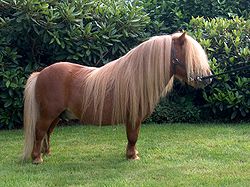|


3-D Flags
Country of Origin: Shetland Islands, United Kingdom

Shetland Pony Stamp
The Shetland pony is a breed of pony originating in the Shetland Isles. Shetlands range in size from a minimum height of approximately 28 inches to an official maximum height of 42 inches (10.2 hands, 107 cm) at the withers. (11.2 hands for American Shetlands) Shetland ponies have heavy coats, short legs and are considered quite intelligent. They are a very strong breed of pony, used for riding, driving, and pack purposes.
History
Shetland ponies originated in the Shetland Isles, located northeast of mainland Scotland. Small horses have been kept on the Shetland Isles since the Bronze Age. People who lived on the islands probably later crossed the native stock with ponies imported by Norse settlers. Shetland ponies also were probably influenced by the Celtic Pony, brought to the islands by the Celts between 2000 and 1000 BC.[citation needed] The harsh climate and scarce food developed the ponies into extremely hardy animals.
Shetland ponies were first used for pulling carts, carrying peat, coal and other items, and plowing farmland. Then, as the Industrial Revolution increased the need for coal in the mid-19th century, thousands of Shetland ponies traveled to mainland Britain to be pit ponies, working underground hauling coal, often for their entire (often short) lives. Coal mines in the eastern United States also imported some of these animals. The last pony mine in the United States closed in 1971.
The Shetland Pony Stud Book Society of the United Kingdom was started in 1890 to maintain purity and encourage high-quality animals. In 1957, the Shetland Islands Premium Stallion Scheme was formed to subsidize high-quality registered stallions to improve the breeding stock.
Uses
A Shetland pony in harness.Today, Shetlands are ridden by children and are shown by both children and adults at horse shows in harness driving classes as well as for pleasure driving outside of the show ring. Shetlands are ridden by small children at horse shows, in riding schools and for pleasure. They are seen working in commercial settings such as fairs or carnivals to provide short rides for visitors. They are also seen at petting zoos and sometimes are used for therapeutic horseback riding purposes. In the United Kingdom, Shetlands are also featured in the Shetland Pony Grand National, galloping around a racecourse with young jockeys.
Junior Harness Racing was founded in Queensland by a group of breeders to give young people age 6 - 16 an opportunity to obtain a practical introduction to the harness racing industry. The children have the opportunity to drive Shetland ponies in harness under race conditions. No prize money is payable on pony races, although winners and place-getters receive medallions.
Miniature Shetlands have been trained as guide horses to take the same role as guide dogs. This task is also performed by other miniature horse breeds.
Characteristics
Shetland Ponies are hardy and strong, in part because the breed developed in the harsh conditions of the Shetland Isles. In appearance, Shetlands have a small head, sometimes with a dished face, widely-spaced eyes and small and alert ears. The original breed has a short, muscular neck, compact, stocky bodies, and short, strong legs and a shorter than normal cannon bone in relation to their size. A short broad back and deep girth are universal characteristics as is a springy stride. Shetlands have long thick manes and tails and a dense double winter coat to withstand harsh weather. Different breed registries have different height standards, but the outside ranges are between a minimum of 7 hands and 11.2 hands (28 to 46 inches (71 to 117 cm)). Distinguishing features: Intelligent, small size, sturdy build, thick coat, compact and strong. American subtype more refined with longer legs and finer coat.
Shetlands can be almost every color, including skewbald and piebald (called pinto in the United States), but are mainly black, chestnut, bay, brown, gray, palomino, dun, roan, cremello, and silver dapple. Registered shetlands are not leopard spotted (Appaloosa), nor do they carry the champagne gene, though these colors are sometimes seen in Shetland-sized crossbreds.
Shetland ponies are generally gentle, good-tempered, and very intelligent by nature. They make good children's ponies, and are sometimes noted for having a "brave" character, but can be very opinionated or "cheeky," and, if not handled properly, can be impatient, snappy, and sometimes become uncooperative, traits often lumped under the label "stubborn" by those who fail to understand that pony behavior is influenced by the quality of human handling. Due in part to their intelligence and size, they are easily spoiled and can be very headstrong if not well-trained.
For its size, the Shetland is the strongest of all horse and pony breeds. It can pull twice its own weight under circumstances where a draft horse can only pull approximately half its own weight, as well as many being able to carry up to 9 stone - 130 pounds (59 kg). Shetland ponies are found worldwide, though mainly in the UK and North America. In general, UK ponies tend to preserve more of the original characteristics of the breed and are often stockier than their American cousins.
Many ponies are long-lived, it is not unusual for a Shetland pony to live more than 30 years. Conversely, their small size also predisposes some individuals to a greater probability of heart problems than in larger animals, on occasion leading to early death. Shetland ponies, like many hardy small horse and pony breeds, can easily develop laminitis if on a diet high in non-structural carbohydrates. Therefore owners must pay careful attention to nutrition, being careful to regulate feed quantity and type...
|